| Article ID | Journal | Published Year | Pages | File Type |
|---|---|---|---|---|
| 5862568 | Toxicology in Vitro | 2011 | 7 Pages |
Polybrominated diphenyl ethers (PBDEs) are flame retardants routinely detected in samples of cord blood and breast milk. Concerns have been raised with regard to the toxicity of both pre- and postnatal exposures towards the developing nervous system. Although there is an increasing body of literature on the disruption of brain cell functions by certain PBDE congeners in vitro, some challenges have yet to be tackled to enable the translation of in vitro findings into their in vivo counterparts. In this paper, we review findings on the PBDE neurotoxicity in human cells and discuss the research gaps to be addressed. Moreover, we propose a scheme for the incorporation of in vitro data in human risk assessment, namely through (i) the determination of in vitro cell benchmark levels; (ii) the consideration of uncertainties in establishing equivalency between the in vitro and the in vivo tissue benchmark levels (e.g., chronic vs. acute exposure, interactions with other chemicals); and (iii) relating tissue benchmark levels to surrogate levels of internal exposure. Alongside the assessment of brain dosimetry following exposure to PBDEs, in vitro neurotoxicity data provide a unique opportunity to evaluate the risks of prenatal and early life exposures on children neurodevelopment.
⺠Studies on human PBDE neurotoxicity are reviewed. ⺠A scheme is proposed for the incorporation of in vitro benchmark data into human risk assessment. ⺠The importance of adequate pharmacokinetic modeling for exposure assessment is emphasized. ⺠Uncertainties and limitations in extrapolating in vitro data to the in vivo situation are discussed. ⺠Research needs and perspectives are highlighted.
